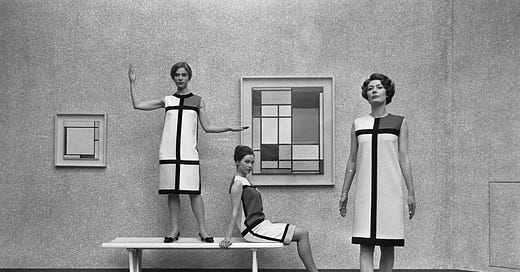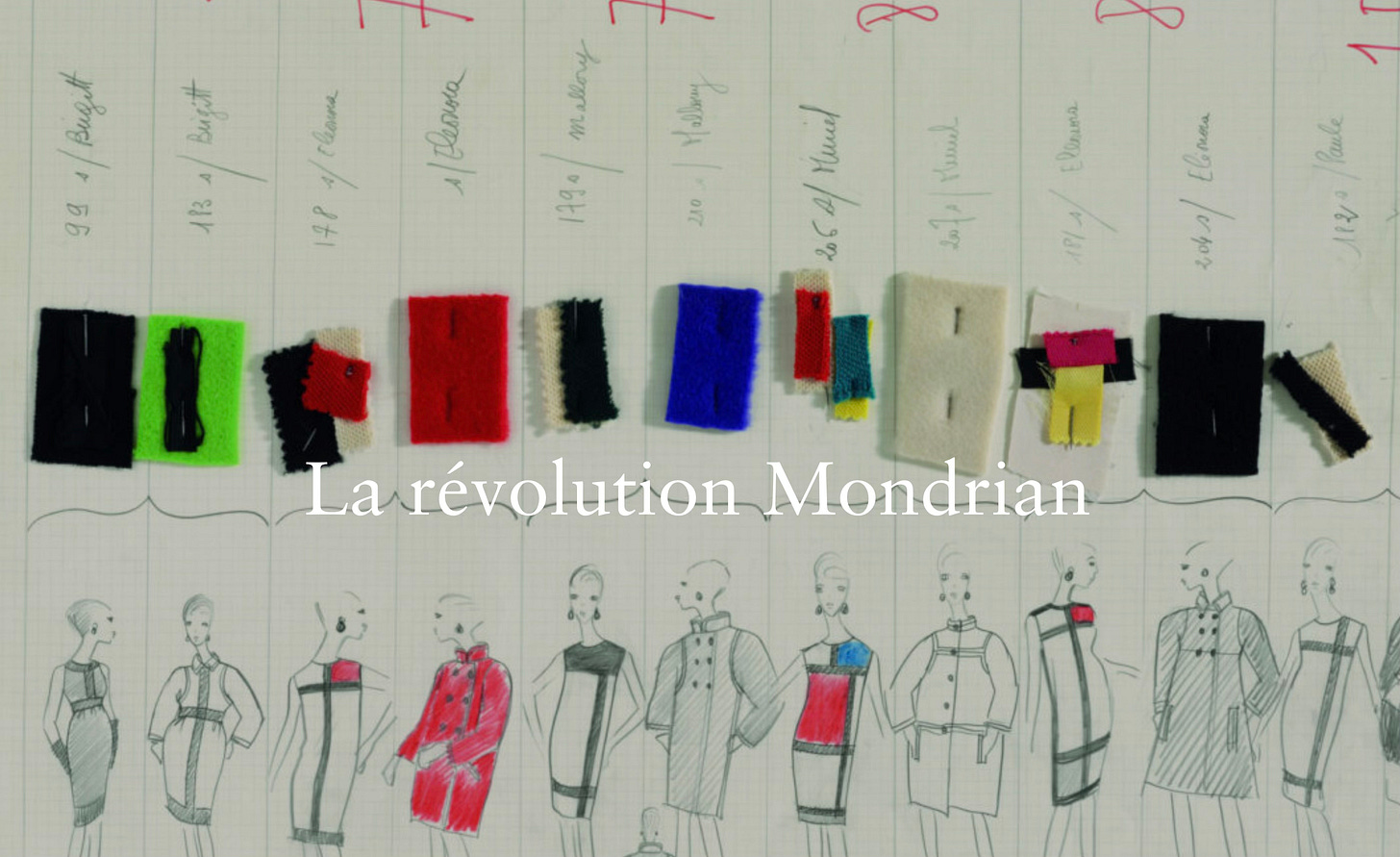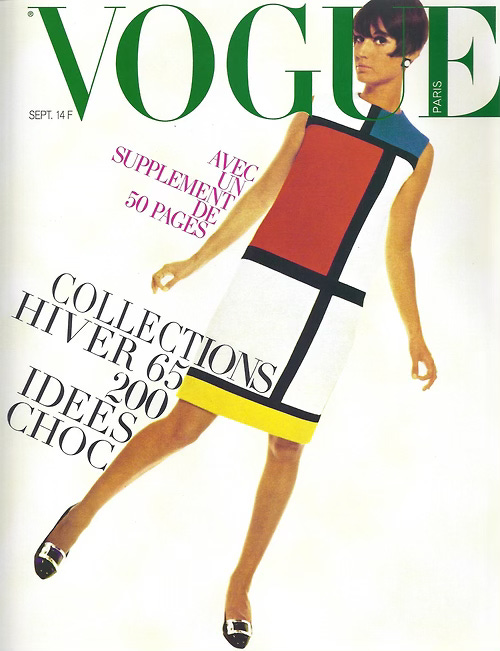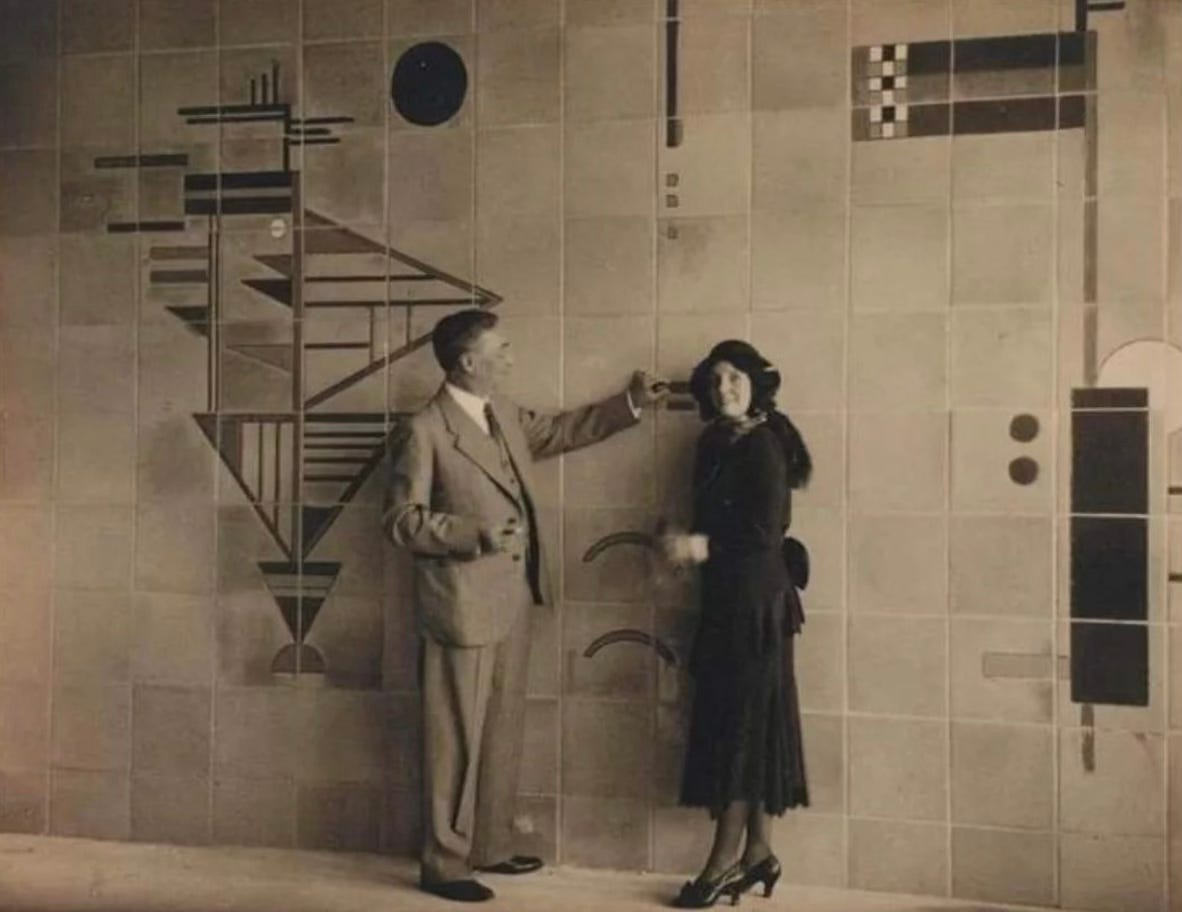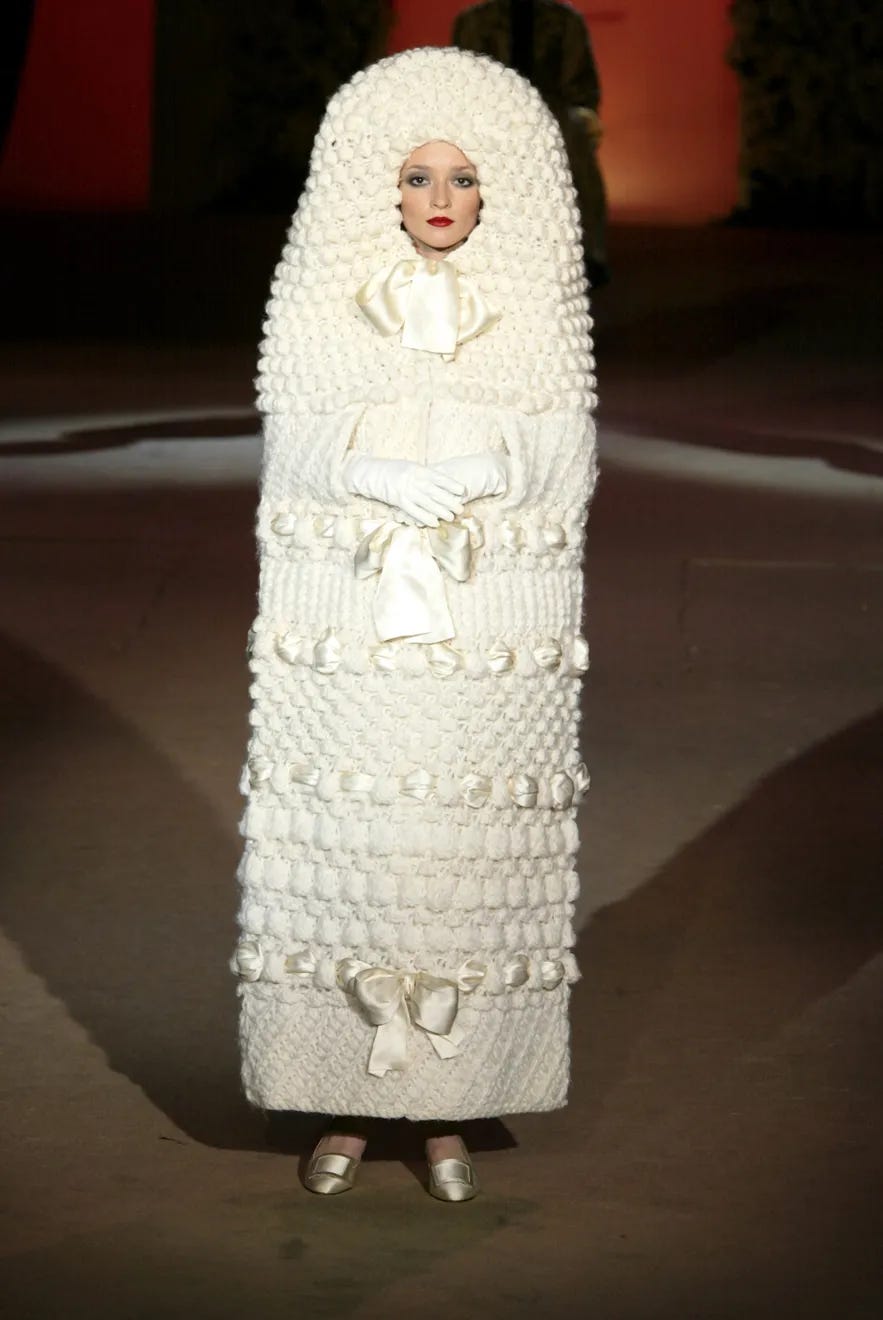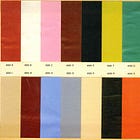YSL's 1965 Autumn/Winter Couture Mondrian Collection
On how the prolific artist's visual cadre became a cultural staple of fashion and design.
❥ This email may be truncated in your inbox. To make sure you are reading the entire post, please move yourself along to a web browser!
All words here are my own, unless otherwise stated. More from me + Absolument can be found in these places:
Website | Instagram | Book Recs - Merci, thank you tons and tons for reading!
Pieter Cornelis Mondriaan AKA Piet Mondrian is—who I’d say—one of the most internationally recognized modern artists. I think if I were to ask anyone if they knew the name of any modern painters, they’d probably say either: Picasso, Dalí, or Mondrian. Maybe Matisse can be thrown in there too! Even if someone doesn’t know Mondrian by name directly, I’m sure many could likely recall in their visual memory the paintings made of yellow, blue, white, and red squares framed by black lines in various compositions.
A 1937 press release from MoMA claimed him as “now generally considered the foremost living master of abstract geometrical design in painting.” Another release commended him for “greatly simplifying his style until he had reduced it to a few straight black lines bounding white rectangles with an occasional area of pure red, blue, or yellow.” He became memorable fast and remained in the top rankings of art.
In the minds of the general public, why did Mondrian’s geometric, primary color-hued blocking stick better than Kazimir Malevich’s Black Square or Ellsworth Kelly’s color-soaked canvases? Did fashion have anything to do with it? More specifically: do we have YSL to thank for Piet’s lasting iconographic popularity?
The Museum of YSL in Paris spreads news of “La Révolution Mondrian”—the wave of the modern painter-inspired women’s wear collection that hit the world’s eyes in August 1965. “This period coincides with an emancipation of women who like to dress in casual dresses, whose cuts constrain the body less and less. What also characterizes the fashion of the mid-60s is the appearance of bright colors and bold blends.”
Out of 160 models that walked the runway for Yves Saint Laurent in Autumn Winter 1965, twenty-six sported Mondrian looks. In fact, the Mondrian dresses were created only in the month prior to the runway show, after YSL himself had produced simple sketches while swimming in a high level of Piet-induced inspiration. Turns out: his mother gifted him a book on Mondrian’s paintings, and he was taken by the artist’s ability to paint with absolute “purity.” Way to go, mom!
The collection was so prolifically adored that knock-offs were immediately in production, trickling down to the fast-fashion equivalents of the late-1960s. It got to the point at which YSL admitted, exasperatedly, “I hate Mondrian now.”
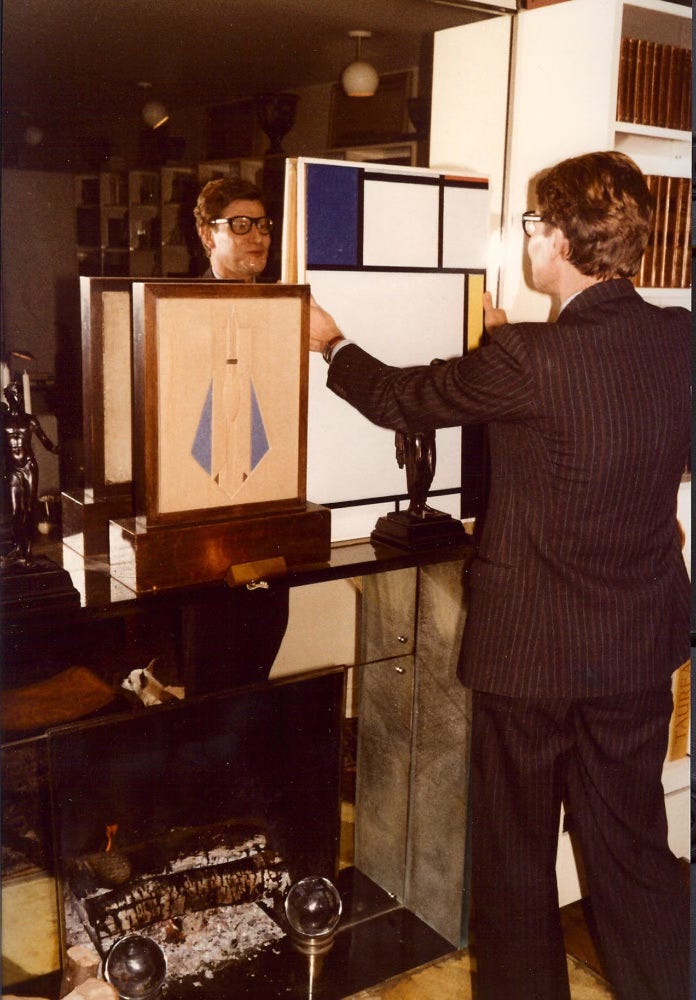
There is a fascinating video below in which we get the chance to visit the archival collection of Musée Yves Saint Laurent and watch as conservators handle and describe the pieces. The subtitles are in English, but the sounds are purely in French. “Roh-la-la-laa!” exhaled the creator of the video, Loic Prigent, as he first laid eyes on the vault. I gasped a little as well. They explained how the collection came to be and how the clothes were exquisitely tailored. The museum was reunited with a dress at auction (they dove into French laws about protecting cultural heritage, which is super interesting), and the topic of restoration discussed. Surprisingly, YSL was only four years into its couture house, and the Mondrian collection helped seal the brand into the canon of couture design.
This brings me back to the one curiosity I’m always wondering about, mostly thanks to a handmade Halloween costume of my past. I noted that so many people recognized my costume, but I had mixed responses about why people knew what I was dressing up as. At the time, I lived in a pretty un-focused part of the world when it came to art and fashion. I’m wondering: do most people today recognize this assortment of geometry and primary colors first as an abstract painting by Piet Mondrian? Or is their association a Yves Saint Laurent shift dress? Are we culturally more impacted by the original paintings, or the commodification of them into women’s wear?

Related Notes:
“But style for [Mondrian], from first to last, served a quest to manifest soul-deep spirituality as a demonstrable fact of life. His aim, he said, was not to create masterpieces, though he did that, too. It was ‘to find things out.’ He reduced painting’s uses and procedures, the whats and the hows, to a rock-bottom why.”From Excavating the Mysteries of Mondrian’s Greatness by Peter Schjeldahl.
Another New Yorker writing: the discovery that a Mondrian painting was being displayed upside down at a German Museum for half of a century. They begin to question everything; they become spiritual too. “Museums are indeed the churches of progressive-minded people, since they celebrate just the qualities that fanatics and dogmatists want to quelch: the vigorous acceptance of uncertainty that lets us ask new questions and leaves us unsure about which way is up.”
There was a house in the Outer Sunset neighborhood of San Francisco that was affectionately painted as an oversized Mondrian painting. Visiting it was one of my hobbies when I spent a year living in the city. I’ve been told that it has recently caught beige-itis and looks more like an unfrosted spongecake. I wish I could confirm, but the entire house is blurred on Google Maps! My San Francisco people: are we beige or are we still deliciously Mondrian?
Wassily and Nina Kandinsky in the Bauhaus Salon de Musique in 1931 via areasvellas:
Also in this YSL F/W 1965 collection was a knitted wedding dress:
I love when My Art Broker posts street interviews asking strangers—in the most chipper and approachable English voice—about their favorite piece of art. People tend to think that the subject requires a ton of deep thought and education. You can sense the immediate anxiety of the interviewees. Thankfully it always softens as they start to search for their answer. In reality, anyone can feel connected to a work of art. It’s always sweet to watch/listen to what people gravitate toward and why.
Other related Absolument art posts:
**
Wear Mondrian/YSL or…be square.
Kelsey Rose


